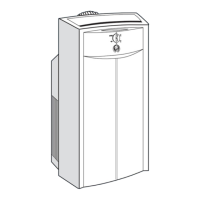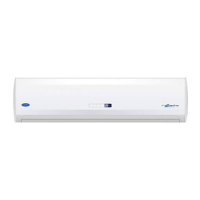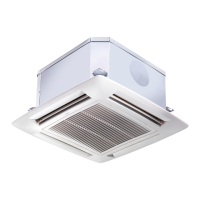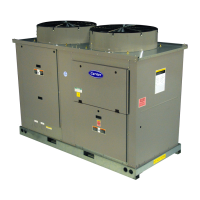T -295
4-2
SERVICE
PORT
VALVE CAP
VALVE
STEM
TO DISCHARGE OR
FROM SUCTION
LINE
PORT TO
COMPRESSOR
Service Valve
Frontseated
(clockwise)
Service Valve
Backseated
(counterclockwise)
Figure 4-2.Suction or Discharge Service Valve
4.4 INSTALLING MANIFOLD GAUGE SET
A manifold gauge set (Figure 4-3) can be used to
determine system operating pressures, add charge,
equalize or evacuate the system.
Hand Valve
(Backseated)
Hand Valve
(Frontseated)
Suction
Pressure
Gauge
Discharge
Pressure
Gauge
ABC
A. Connection to Low Side of System
B. Connection to High Side of System
C. Connection to Vacuum Pump, Refrigerant
Cylinder , Oil Container or Evacuation Line
Figure 4-3. Manifold Gauge Set
When the suction pressure hand valve is frontseated
(turned all theway in), thesuction(low)pressure can be
read. When the discharge pressure hand valve is
frontseated, discharge (high) pressure can be read.
When both valves are open (turned counterclockwise),
high pressure vapor will flow into the low side. When
only the low pressure valve is open, the system can be
charged or evacuated. To install a manifold gauge set,
do the following (refer to Figure 4-4, Figure 4-5 or
Figure 4-6 as applicable).
a. Remove the service valve stem caps and backseat
(counterclockwise) both valves. Remove the service
port caps.
b. Connect the discharge side hose tightly to the service
valve port.
c. Connect the suction side hose looselyto theotherser-
vice valve port.
d. Loosen charging (center) hose at dummy fitting of
manifold set.
e. Frontseat (clockwise) both manifold gauge hand
valves.
f. Turn the service valve connected to the discharge
gauge port toward frontseat (clockwise) approxi-
mately 1/4 to 1/2 turn.
g. Slowly turn the manifold discharge hand valve t o-
ward backseat (counterclockwise) approximately
one turn.
h. Tighten charging hose onto dummy fitting.
i. Slowly turn the manifold suction hand valve toward
backseat (counter--clockwise) to remove air from
line.
j. Ti ghten suction hose at the service valve port.
k. Frontseat (close) both manifold hand valves.
l. Turn the servicevalve connected to the suction gauge
port toward frontseat (clockwise) approximately 1/4
to 1/2 turn.
4.5 PUMPING THE SYSTEM DOWN OR REMOV-
ING THE REFRIGERANT CHARGE
NOTE
To avoid damage to the earth’s ozone layer, use
a refrigerant recovery system whenever remov-
ing refrigerant.
4.5.1 System Pump Down For Low Side Repair
To service or replace the filter--drier, thermostatic
expansion valve, suction line or evaporator coils, pump
the refrigerant to the condenser and receiver as follows:
a. Install manifold gauge set. Refer to Figure 4-4
b. Frontseat the filter--drier inlet service valve by turn-
ing clockwise. Disconnectsuctionpressuretransduc-
er and install a jumper on the compressor mounted
low pressure switch.
c. Start the system and run in cooling. Stop the unit
when suction reaches 10 ”/hg (25.4 cm/hg) vacuum.
d. Frontseatcompressor suctions ervicevalveto trapre-
frigerant in the high side of the system between the
compressor suction service valve and the filter--drier
inlet valve. Wait 5 minutes to verify that system re-
mains i n a vacuum. If system pressure rises above
vacuum, open compressor suction service valve and
repeat steps c and d until system remains in vacuum.
e. Service or replace necessary components.
f. Leak check connections and replace filter--drier. Re-
fer to paragraph 4.6.
g. Using refrigerant hoses designed for vacuum service,
evacuate and dehydrate the low side of the system by
connecting a vacuum pump to center connection of
manifoldgauge set. Evacuatesystem t o 500 microns.
Close offpump valve, isolatevacuum gauge andstop
pump. Wait 5 minutes to verify that vacuum holds.
h. Recharge low side to 20 to 30 psig (1.36 to 2.04 bar)
by admitting vapor from the refrigerant cylinder.

